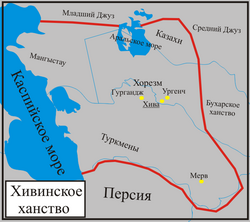Khanate of Khorazm
| Khanate of Khiva | ||||||||
| Semi-independent state (under Russian protection 1873–1917) |
||||||||
|
||||||||
|
The Khanate of Khiva (bordered in red), c. 1700.
|
||||||||
| Capital | Khiva | |||||||
| Languages | ||||||||
| Religion | Islam | |||||||
| Government | Absolute monarchy | |||||||
| Khan | ||||||||
| • | 1511–1518 | Ilbars I (first) | ||||||
| • | 1918–1920 | Sayid Abdullah (last) | ||||||
| History | ||||||||
| • | Established | 1511 | ||||||
| • | Kungrad dynasty established | 1804 | ||||||
| • | Russian conquest | 12 August 1873 | ||||||
| • | Disestablished | 2 February 1920 | ||||||
| Area | ||||||||
| • | 1911 | 67,521 km2 (26,070 sq mi) | ||||||
| Population | ||||||||
| • | 1902 est. | 700,000 | ||||||
| • | 1908 est. | 800,000 | ||||||
| • | 1911 est. | 550,000 | ||||||
| Density | 8/km2 (21/sq mi) | |||||||
|
||||||||
| Today part of | ||||||||
The Khanate of Khiva (Uzbek: خیوه خانلیگی, translit. Xiva xonligi, Persian: خانات خیوه) was a Central Asian Turkic state that existed in the historical region of Khwarezm from 1511 to 1920, except for a period of Afsharid occupation by Nadir Shah between 1740 and 1746. The Khans were the patrilineal descendants of Shayban (Shiban), the fifth son of Jochi and grandson of Genghis Khan. Centred in the irrigated plains of the lower Amu Darya, south of the Aral Sea, with the capital in the city of Khiva, the country was ruled by an Uzbek Turkic tribe, the Khongirads, who came from Astrakhan. It covered present western Uzbekistan, southwestern Kazakhstan and much of Turkmenistan before Russian arrival at the second half of the 19th century.
In 1873, the Khanate of Khiva was much reduced in size and became a Russian protectorate. Following the Russian Revolution of 1917, Khiva had a revolution too, and in 1920 the Khanate was replaced by the Khorezm People’s Soviet Republic. In 1924, the area was formally incorporated into the Soviet Union and today is largely a part of Karakalpakstan and Xorazm Province in Uzbekistan.
...
Wikipedia


